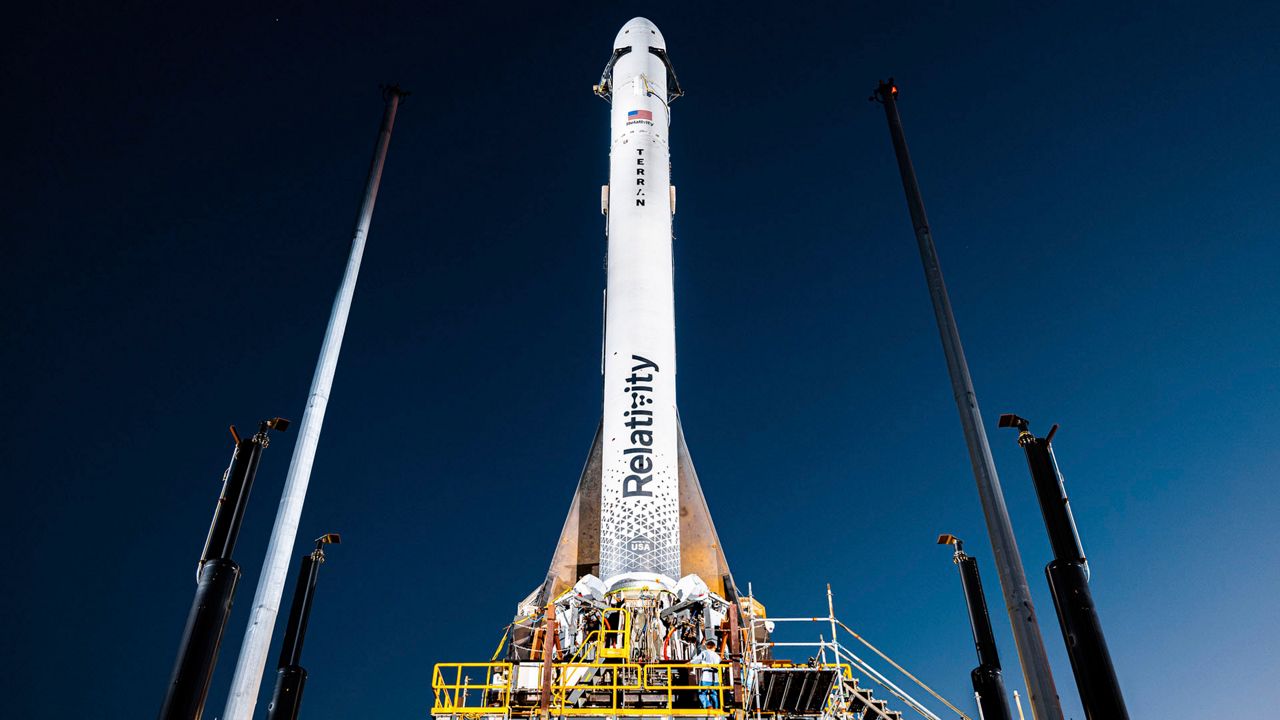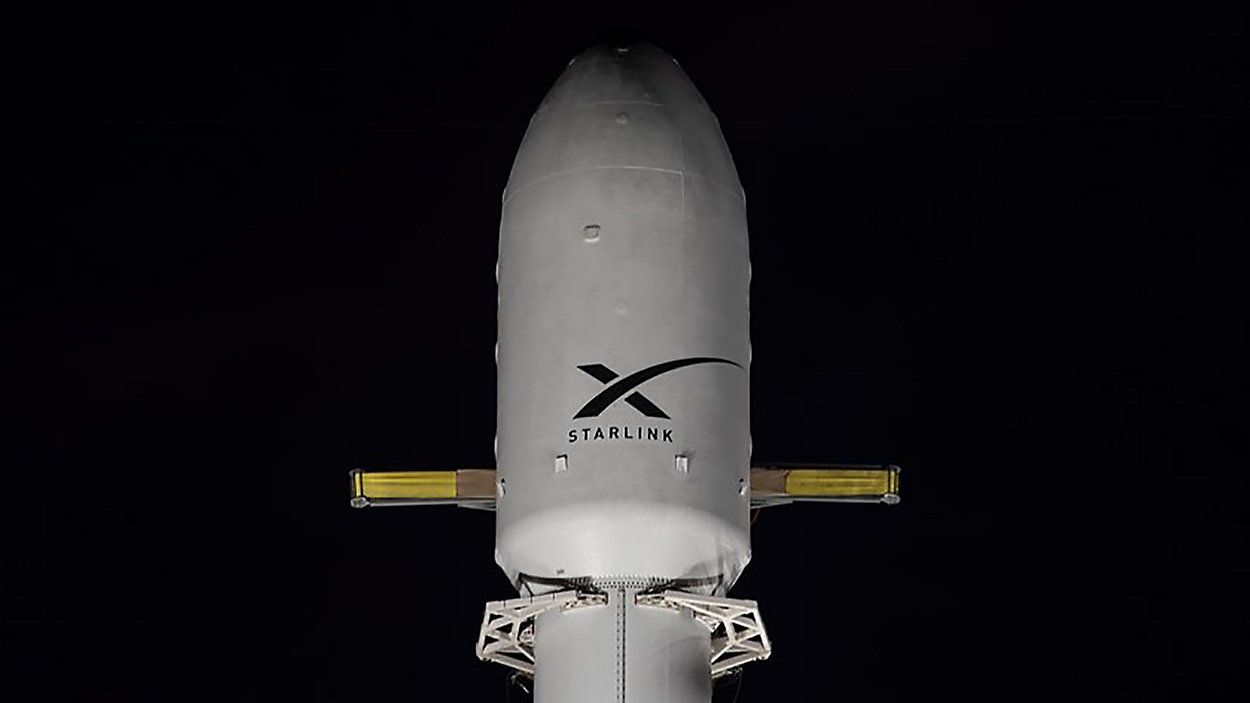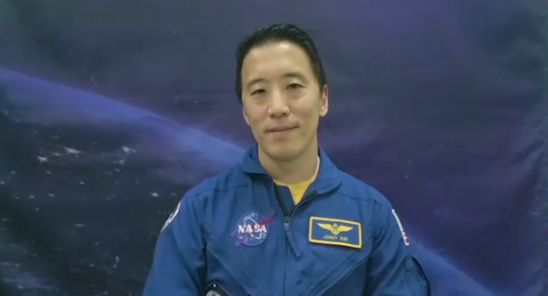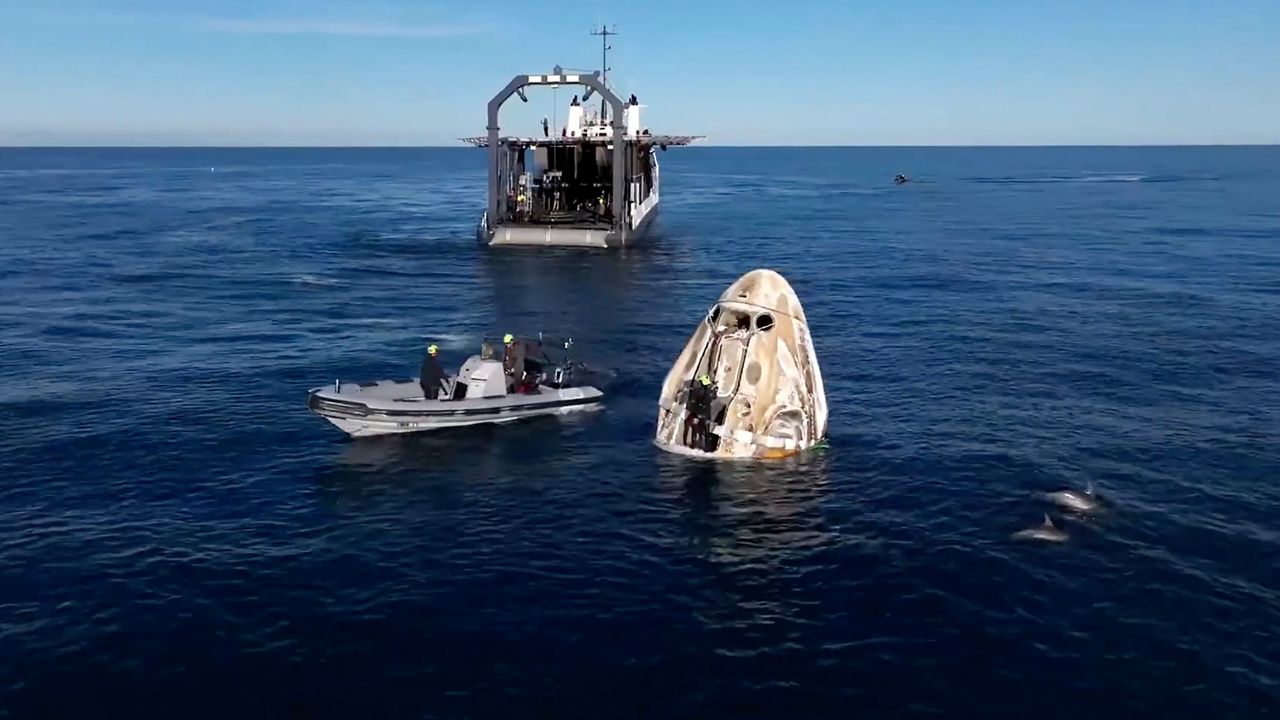CAPE CANAVERAL SPACE FORCE STATION — Despite the number of struggles Relativity Space has faced trying to get the world’s first 3D-printed rocket off the ground, it finally succeeded Wednesday night, even if it did not reach orbit and the second-stage engine suffered an anomaly, stated the company.
What You Need To Know
- Second-stage engine suffered an anomaly
- 85% of the rocket has been 3D-printed, says Relativity Space
- A UCF professor shares how he is the lead researcher in a new style of rocket
- 🔻Scroll down to watch the launch🔻
The Terran 1 rocket named Good Luck, Have Fun, lifted off from Launch Complex 16 in Cape Canaveral at 11:25 p.m. EDT.
During its maiden voyage, the 85% 3D-printed, 110-foot-tall rocket raced toward the night sky. Cheers and screams of joy were heard from Relativity Space’s team as the rocket hit many of the checkmarks as it continued to climb.
However, the stage-two engine, a single Aeon Vac engine, suffered an anomaly, Arwa Tizani Kelly, P.E., who is a technical program manager for test and launch at Relativity Space, said during a live broadcast.
While it did not reach orbit, the rocket did reach Max-Q and stage separation.
Kelly's co-host, Dr. Raichelle Aniceto, stated that the company would reveal what exactly happened at a later date.
Despite the setback, the two stayed positive.
“No one ever attempted to launch a 3D-printed rocket into orbit and while we didn’t make it all the way today, we gathered enough data to show that flying 3D-printed rockets is possible,” Kelly said.
“We will apply the lessons learned today to our future vehicle Terran R,” said Aniceto, chief of staff of the vehicle architecture and technology department for the company. “What we are doing has never been done before, but it is undoubtedly a worthwhile endeavor that will transform the aerospace industry forever."
Relativity Space issued a tweet after midnight, listing off the "historic firsts" of the launch.
Today’s launch proved Relativity’s 3D-printed rocket technologies that will enable our next vehicle, Terran R. We successfully made it through Max-Q, the highest stress state on our printed structures. This is the biggest proof point for our novel additive manufacturing approach.… pic.twitter.com/9iaFVwYoqe
— Relativity Space (@relativityspace) March 23, 2023
Third attempt trials
For the third launch attempt of the world's first 3D-printed rocket, Relativity Space has had three holds on Wednesday night: The first for upper-level winds, a second for a boat being in the range and a third for upper-level winds again.
But now the company has issued a new launch time of 11:25 p.m. EDT, for Wednesday's liftoff of the Terran 1 rocket.
At around 10:53 p.m., Relativity Space stated during its live feed broadcast that upper-level winds once again placed a hold on the countdown clock, but minutes later, stated that the new possible time would be 11:25 p.m. EDT.
At around 10:15 p.m., Relativity Space put a hold at T-25 due to a boat in the range, the company stated during its live feed broadcast.
We're currently on hold at T-25:00 due to a vessel currently violating our range space. Standby for an updated T-0 time.
— Relativity Space (@relativityspace) March 23, 2023
The punishment for such an act can be severe, according to Space Launch Delta 45.
"Any person or vessel requesting to enter, pass through or remain in the RNA shall request authorization from the Captain of the port under the authority of 33 CFR 160.111 and Title 46, United States Code (USC), Parts 70002 and 70036. No person or vessel may enter the Security Zone. Failure to comply is punishable by a fine of not more than $250,000 or imprisonment for not more than six years, or both," it stated.
A boat was in range during the second launch attempted on Saturday, March 11.
Earlier Wednesday evening, the private California-based company tweeted out that it put a hold at T-45 as it was observing strong upper-level winds and would send a weather balloon up to monitor the conditions.
We're currently monitoring strong upper level winds and will be holding at T-45:00. The start of our livestream will be delayed. Stay tuned as we await an update from the next weather ballon.
— Relativity Space (@relativityspace) March 23, 2023
Later, the company tweeted that the data from the balloon was "trending positively," with Relativity Space CEO Tim Ellis announcing that the countdown clock had once again begun.
Here. We. Go! T-45 and counting pic.twitter.com/NfeFBmzOne
— Tim Ellis (@thetimellis) March 23, 2023
On Friday, March 17, Relativity Space announced that it was going to attempt the third launch of its Terran 1 rocket Good Luck, Have Fun, from Launch Complex 16 in Cape Canaveral on Wednesday, March 22.
Due to the holds, the three-hour launch window opens at 11:25 p.m. EDT. The launch time had shifted from the original 10 p.m. EDT to 10:38 p.m. EDT to 11:05 p.m. EDT.
Join us late night on March 22nd for our #GLHF launch, part 3. Our launch window is from 22:00 – 01:00ET. Nighttime skies mean very cool methane rocket engine plumes.😎 https://t.co/ccyT1Gahqo
— Relativity Space (@relativityspace) March 17, 2023
On Tuesday, March 21, the 45th Weather Squadron gave a 95% chance of good weather for the possible mission, with the only primary concern being the cumulus cloud rule.
It’s launch day. #GLHF pic.twitter.com/swkXumHnEh
— Relativity Space (@relativityspace) March 22, 2023
The second attempt
Relativity Space tried to get the Terran 1 rocket off the ground three times on Saturday, March 11. The three-hour-launch window opened at 1 p.m. EST, just like during the first attempt on Wednesday.
For Saturday, the first attempt was held at T-20 due to upper-level wind violations. The next attempt was aborted at 0.5 seconds, with Relativity citing "launch commit criteria violations."
The final try was aborted at 45 seconds as the clock ticked past Saturday's three-hour launch window.
During abort #1: It was a corner case in the stage separation automation a few seconds before T-0 that properly aborted at T .5 seconds.
— Relativity Space (@relativityspace) March 11, 2023
During abort #2: At T-45 seconds, we had an automated abort on stage 2 fuel pressure, which was only one PSI low.
— Relativity Space (@relativityspace) March 11, 2023
Relativity Space has not yet announced its third attempt to launch the Terran 1 rocket.
‘It’s a new rocket’
Many space fans traveled from all over to watch Relativity Space’s rocket, like Scott Ferguson who brought his 11-inch Celestron telescope to view the Terran 1.
“I was hoping to use some software that I developed today to track this launch, but of course, we had two aborts there during that final countdown part, which is a bit heartbreaking. But it’s a new rocket, so it’s not unexpected,” he said at a rocket launch viewing area by the A1A in Merritt Island.
Ferguson hopes the next launch attempt is on a weekend so he can capture it with his telescope, but it is not the first time he has done this.
On his YouTube channel Astronomy Live, many can view videos of the launches he has captured, such as the Falcon Heavy and the Artemis 1 launch.
“So with this setup, I tracked a number of launches, some of my favorites include, of course, the Falcon Heavy launch we had a couple of months ago. That one was gorgeous at sunset. I also tracked Artemis 1,” Ferguson listed off.
🚀Scott Ferguson (@astroferg) tells me about his amazing set up of how he is able to capture launches with his telescope.
— Anthony Leone (@AnthonyLeone) March 13, 2023
He hoped to get @relativityspace’s #Terran1 launch of #GLHF on Saturday.
Hear more about it & how you can see his launch videos. https://t.co/8VyfBdso7L pic.twitter.com/9cX0bBhgvy
The first attempt
An initial launch attempt Wednesday afternoon, March 8, was scrubbed because of a fuel mixture issue. Relativity Space scrubbed the launch after the last attempt at 3:45 p.m.
After Wednesday's scrubbed launch attempt, the company's CEO Tim Ellis tweeted the reason behind what went wrong, saying, "due to methane/Liquid Natural Gas propellant conditioning, it will take a few days until our next attempt."
The rocket was originally set to launch at 1 p.m. from Space Launch Complex 16 at Cape Canaveral Space Force Station.
The 45th Weather Squadron had given a 90% chance of good launch weather for Wednesday, with the only concern being the cumulus cloud rule. The same percentage and rule is being given for Saturday's launch.
Engineering the rocket
The 110-foot-tall rocket — christened Good Luck, Have Fun (GLHF) — is made of a metal-aluminum alloy and is the first orbital endeavor by the California-based aerospace company.
At 7.5 feet wide, GLHF is expendable and is the largest 3D-printed rocket, stated Relativity Space.
Dr. Kareem Ahmed, an associate professor in the University of Central Florida’s Department of Mechanical and Aerospace Engineering, explained to Spectrum News what Relativity Space has done and why it is so different from the rockets that many have seen go up from the Space Coast.
“The fact that a large majority 80-90% of the rocket parts are 3D printed” is why GLHF is so different from what has been seen before, Ahmed said. “Yes, the 3D printing approach (has) been tailored to print the majority of the parts.”
And those parts include the nine Aeon engines on the first stage and an Aeon Vac engine on the second stage. The Terran 1 is 85% 3D printed by mass, described by the company. And yes, that includes the engines, confirmed information that Relativity Space shared with Spectrum News.
Ahmed said Relativity Space’s 3D printing process, if successful, will change how rockets will be designed and made.
“Yes, it allows for innovative designs to be implemented and quicker manufacturing,” he said.
To give it the liftoff it needs, liquid oxygen and liquid natural gas are being used as the fuel, but the company mentioned that once it gets to Mars, this style of rocket can be transitioned to methane, which might be available on the Red Planet.
Since this is a maiden launch, Relativity Space stated that there is no crew and no customer payload for this mission.

Knowing his way around a rocket
Ahmed knows a thing or two about rockets. NASA awarded him funding to further develop a different type of rocket engine system.
“We have been working on rotating detonation rocket engines for a while now and have demonstrated (hydrogen and oxygen) rotating detonation rocket engines to work as featured by UCF. Now we have been focusing on the development of this rocket engine technology including liquid propellants and thrust performance,” said Ahmed, who will lead the research.
In an article that Ahmed shared with Spectrum News, the new process will make rockets to be lighter, travel even further and burn cleaner.
“The rotating detonations are continuous, Mach 5 explosions that rotate around the inside of a rocket engine, and the explosions are sustained by feeding hydrogen and oxygen propellant into the system at just the right amounts,” the article explained.
The technology is nothing new and has been around since the 1960s. In fact, Ahmed stated that NASA has demonstrated this type of rotating rocket detonation.









